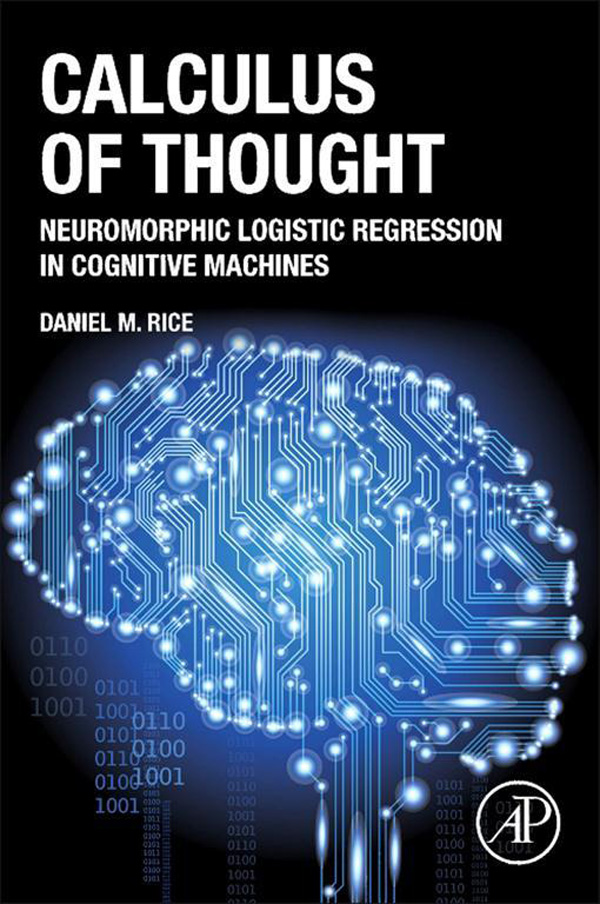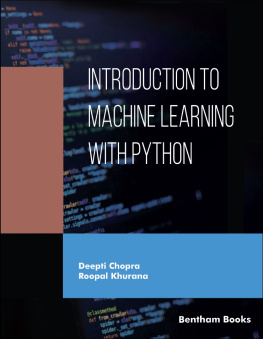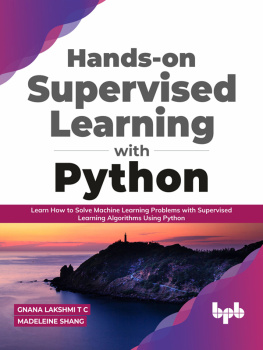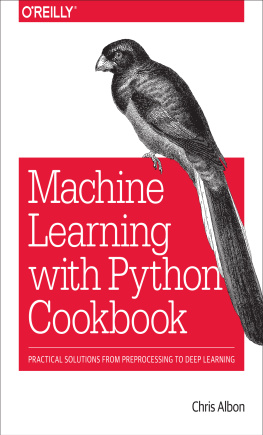Rice - Calculus of thought neuromorphic logistic regression in cognitive machines
Here you can read online Rice - Calculus of thought neuromorphic logistic regression in cognitive machines full text of the book (entire story) in english for free. Download pdf and epub, get meaning, cover and reviews about this ebook. City: Amsterdam, year: 2014;2013, publisher: Elsevier Science;Academic Press, genre: Romance novel. Description of the work, (preface) as well as reviews are available. Best literature library LitArk.com created for fans of good reading and offers a wide selection of genres:
Romance novel
Science fiction
Adventure
Detective
Science
History
Home and family
Prose
Art
Politics
Computer
Non-fiction
Religion
Business
Children
Humor
Choose a favorite category and find really read worthwhile books. Enjoy immersion in the world of imagination, feel the emotions of the characters or learn something new for yourself, make an fascinating discovery.

- Book:Calculus of thought neuromorphic logistic regression in cognitive machines
- Author:
- Publisher:Elsevier Science;Academic Press
- Genre:
- Year:2014;2013
- City:Amsterdam
- Rating:5 / 5
- Favourites:Add to favourites
- Your mark:
- 100
- 1
- 2
- 3
- 4
- 5
Calculus of thought neuromorphic logistic regression in cognitive machines: summary, description and annotation
We offer to read an annotation, description, summary or preface (depends on what the author of the book "Calculus of thought neuromorphic logistic regression in cognitive machines" wrote himself). If you haven't found the necessary information about the book — write in the comments, we will try to find it.
Calculus of thought neuromorphic logistic regression in cognitive machines — read online for free the complete book (whole text) full work
Below is the text of the book, divided by pages. System saving the place of the last page read, allows you to conveniently read the book "Calculus of thought neuromorphic logistic regression in cognitive machines" online for free, without having to search again every time where you left off. Put a bookmark, and you can go to the page where you finished reading at any time.
Font size:
Interval:
Bookmark:

Daniel M. Rice

Academic Press is an imprint of Elsevier
225, Wyman Street, Waltham, MA 02451, USA
The Boulevard, Langford Lane, Kidlington, Oxford OX5 1GB, UK
Radarweg 29, PO Box 211, 1000 AE Amsterdam, The Netherlands
2014 Elsevier Inc. All rights reserved.
No part of this publication may be reproduced, stored in a retrieval system or transmitted in any form or by any means electronic, mechanical, photocopying, recording or otherwise without the prior written permission of the publisher
Permissions may be sought directly from Elsevier's Science & Technology Rights Department in Oxford, UK: phone (+44) (0) 1865 843830; fax (+44) (0) 1865 853333; email: , and selecting Obtaining permission to use Elsevier material
Notice
No responsibility is assumed by the publisher for any injury and/or damage to persons or property as a matter of products liability, negligence or otherwise, or from any use or operation of any methods, products, instructions or ideas contained in the material herein. Because of rapid advances in the medical sciences, in particular, independent verification of diagnoses and drug dosages should be made
Library of Congress Cataloging-in-Publication Data
A catalog record for this book is available from the Library of Congress
British Library Cataloguing in Publication Data
A catalogue record for this book is available from the British Library
ISBN: 978-0-12-410407-5
For information on all Academic Press publications visit our web site at store.elsevier.com
Printed and bound in USA
14 15 16 17 10 9 8 7 6 5 4 3 2 1

I first heard the phrase Calculus of Thought as a second year graduate student in 1981 when I took a seminar called Brain and Behavior taught by our professor James Davis at the University of New Hampshire. He gave us a thorough grounding in the cognitive neuroscience of that day, and he spent significant time on various models of neural computation. The goal of cognitive research in neuroscience, he constantly reminded us, was to discover the neural calculus, which he took to be a complete and unifying understanding of how the brain performs computation in diverse functions such as coordinated motor action, perception, learning and memory, decision making, and causal reasoning. He suggested that if we had such a calculus, then there would be truly amazing practical artificial intelligence applications beyond our wildest dreams. This was before the widespread popularity of artificial neural network methods in the mid-1980s, as none of the quantitative models that we learned about were artificial neural networks, but instead were grounded in empirical data in neural systems like the primary visual cortex and the basal ganglia. He admitted that the models that we were taught fell way short of such a calculus, but he did fuel an idea within me that has stayed for more than 30 years.
I went on to do my doctoral dissertation with my thesis advisor Earl Hagstrom on timing relationships in auditory attention processing as reflected by the scalp recorded Electroencephalography (EEG) alpha rhythm. During the early and mid-1980s, there was not a lot of interest in the EEG as a window into normal human cognition, as the prevailing sentiment was that the brain's electric field potentials were too gross of a measure to contain valuable information. We now have abundant evidence that brain field potential measures, such as the EEG alpha rhythm, are sensitive to oscillating and synchronous neural signals that do reflect the rhythm and time course of cognitive processing. My dissertation study was one of a handful of initial studies to document a parallelism between the oscillating neural synchrony as measured by the EEG and cognition.1 Through that dissertation study, and the advice that I also got from other faculty committee membersJohn Limber and Rebecca Warner, I learned the importance of well-controlled experimental findings in providing more reliable explanations. Yet, this dissertation did not address how basic cognitive computations might be performed by oscillating neural synchrony mechanisms, and my thoughts have wandered back to how this Calculus of Thought might work ever since.
I did postdoctoral fellowship research with Monte Buchsbaum at the University of California-Irvine Brain Imaging Center. Much of our work focused on abnormal temporal lobe EEG slowing in probable Alzheimer's patients and related temporal lobe slowing in nondemented older adults. We published one paper in 1990 that replicated other studies including one from Monte's lab showing abnormal temporal lobe EEG slowing in Alzheimer's patients compared to nondemented elderly, but we critically refined the methodology to get a higher fidelity measurement.2 We published a second paper in 1991 that used this refined methodology to make the first claim that Alzheimer's disease must have an average preclinical period of at least 10 years.3 Our basic finding was that a milder form of the temporal lobe EEG slowing observed in Alzheimer's patients was seen in nondemented older adults with minor memory impairment. This observed memory impairment had the exact same profile as what neuropsychologist Brenda Milner had observed in the famous medial temporal lobe patient H.M. This is the most famous clinical case study in neuroscience.4 This was that there was normal immediate recall ability, but dramatically greater forgetting a short time later. Other than this memory deficit, we could find nothing else wrong in terms of cognitive and intelligence tests with these nondemented older adults. Given the nature of the memory deficit and the location of the EEG abnormality, we suggested that the focus of this abnormality must be in the medial temporal lobe of the brain. Given the prevalence of such EEG slowing in nondemented older adults and the prevalence of Alzheimer's disease, we calculated that this must be a preclinical sign of Alzheimer's disease that is present 10 years earlier than the clinical diagnosis. We had no idea how abnormal neural synchrony might be related to dysfunction in memory computations, but ever since my thoughts have wandered back to how this Calculus of Thought could go awry early in Alzheimer's disease.
Our claim that there is a long preclinical period in Alzheimer's disease with a major focal abnormality originating in the medial temporal lobe memory system has now become the prevailing view in Alzheimer's research.5,6,7 This evidence for the long preclinical period is such that the National Institute on Aging issued new diagnostic recommendations in 2011 to incorporate preclinical Alzheimer's disease into the clinical Alzheimer's disease diagnosis.8 Yet, when I moved to a new assistant professor position at the University of Southern California (USC) in the earlier 1990s and tried to get National Institutes of Health (NIH) funding to validate this hypothesis with a longitudinal, prospective study, my proposals were repeatedly not funded. It was not controversial that Alzheimer's starts with medial temporal lobe memory system problems, as almost everyone believed that was true. However, I was a complete newcomer, and the idea that Alzheimer's had such a long preclinical period was just too unexpected to be accepted as reasonable by the quorum needed to get NIH funding. It was then that I began to have recollections of Thomas Kuhn's theory about bias in science taught by my undergraduate history of science professor Charles Bonwell many years earlier. Kuhn warned that the established scientific community is often overinvested in the basic theory in their field that he called paradigm.9 Kuhn argued that this bias precludes most scientists from considering new results and hypotheses that are inconsistent with the paradigm. In the early 1990s, the entire Alzheimer's clinical diagnostic process and pharmaceutical research were only concerned with actual demented patients. So any results or explanation that there is in fact a long 10-year preclinical period was not yet welcome. As it turns out, the only hope to prevent and treat Alzheimer's disease now seems to be in this very early period when the disease is still mild,10 as all drug studies in actual demented patients have not really worked. At that time, I was not yet familiar with Leibniz's concept of
Font size:
Interval:
Bookmark:
Similar books «Calculus of thought neuromorphic logistic regression in cognitive machines»
Look at similar books to Calculus of thought neuromorphic logistic regression in cognitive machines. We have selected literature similar in name and meaning in the hope of providing readers with more options to find new, interesting, not yet read works.
Discussion, reviews of the book Calculus of thought neuromorphic logistic regression in cognitive machines and just readers' own opinions. Leave your comments, write what you think about the work, its meaning or the main characters. Specify what exactly you liked and what you didn't like, and why you think so.














![Chris Monahan [Chris Monahan] - Calculus II](/uploads/posts/book/119088/thumbs/chris-monahan-chris-monahan-calculus-ii.jpg)
